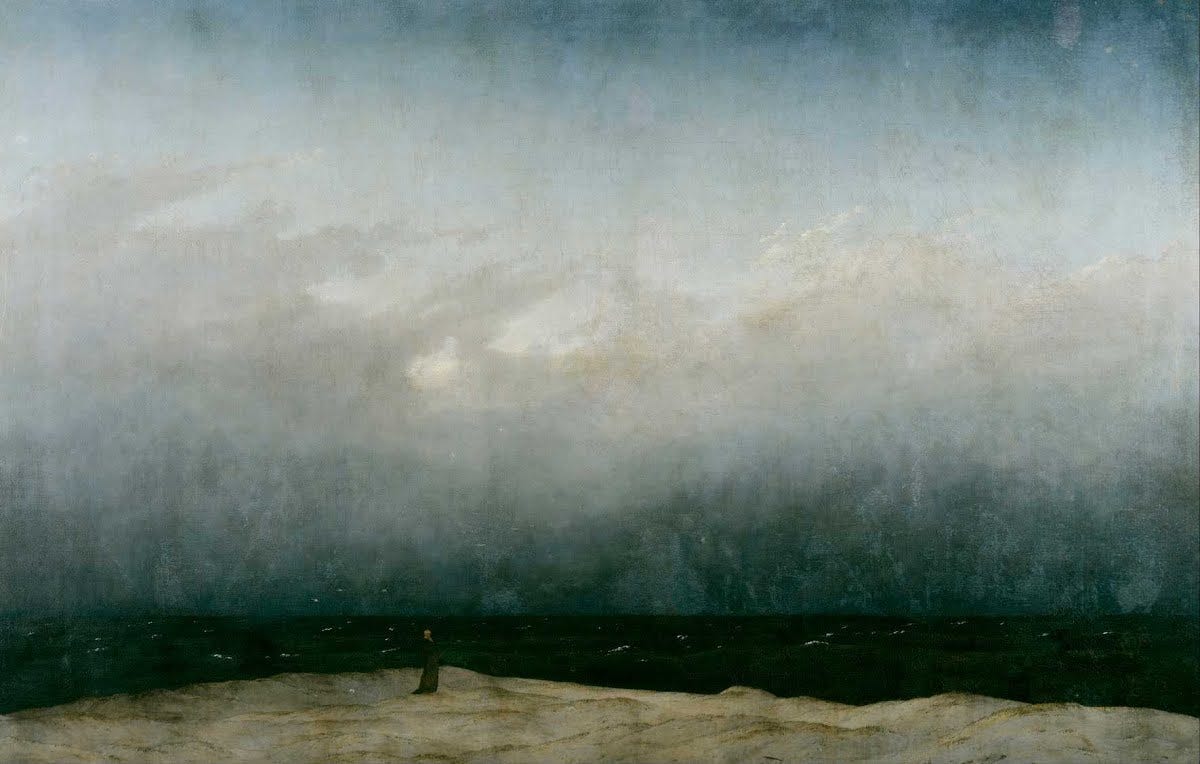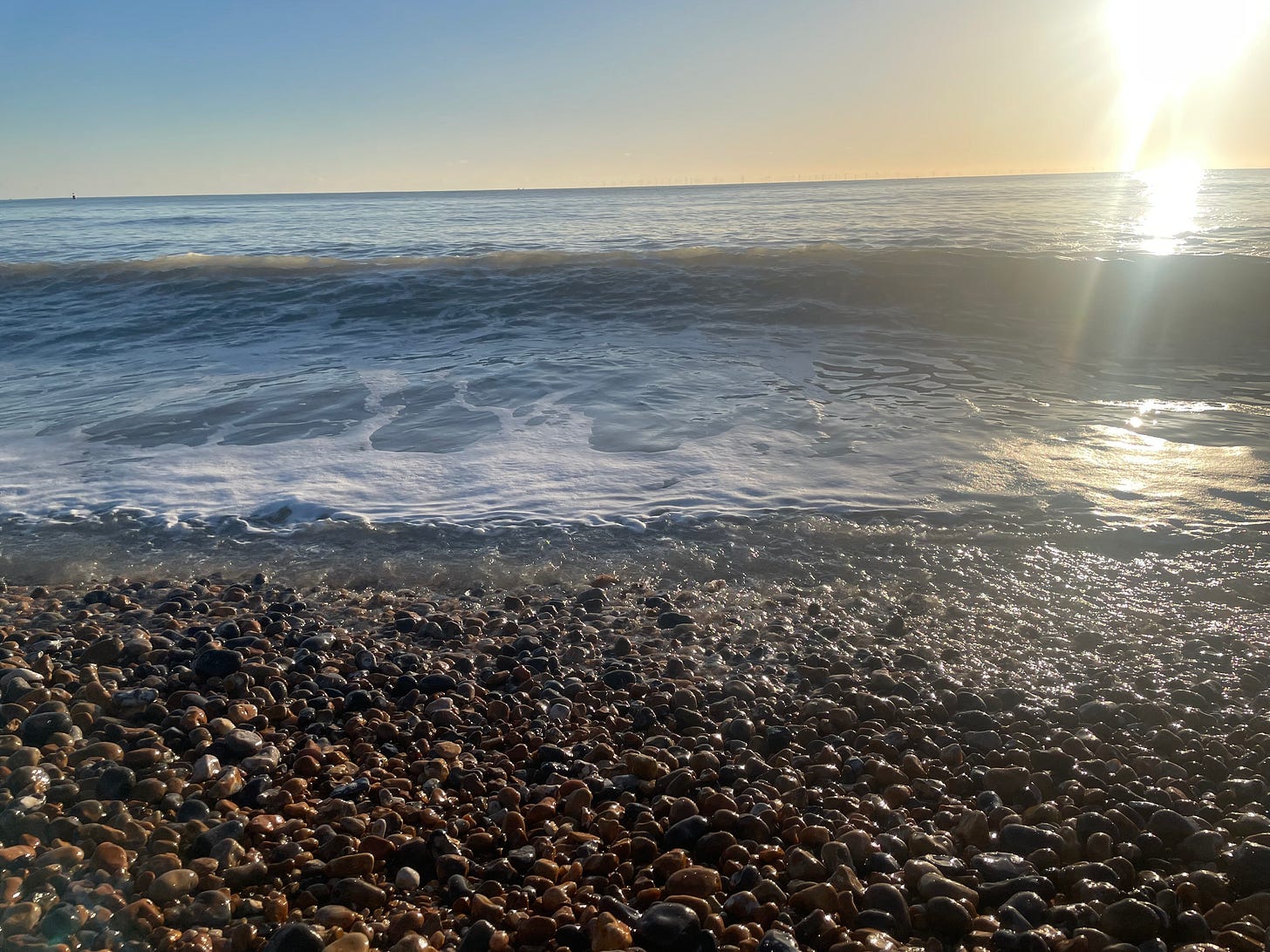Ocean Whoosh
On being a creature in the age of intelligent machines
Welcome to this update from New World Same Humans, a newsletter on trends, technology, and society by David Mattin.
If you’re reading this and haven’t yet subscribed, join 28,000+ curious souls on a journey to build a better future 🚀🔮
At the end of last year, my family and I moved to the sea. Specifically, to Brighton, a town on the English south coast.
It’s been a wonderful move in all kinds of ways. One obvious benefit is that the ocean is now a part of my life. It’s a ten minute walk, past tall, stucco-white Georgian houses and through the centre of town, to the seafront.
As you know, looking out to sea is a whole experience of its own. The massive sky; the horizon. But what I’ve noticed most on my daily pilgrimage — at least, once I reach the water’s edge — is the sound.
Brighton has a pebble beach. The waves break onto the stones and then the water withdraws, readying itself for the next wave. And when the water withdraws it makes this grainy, layered rushing sound. It’s as though you can hear the voice of each stone, a chorus that is tens of millions of voices, singing together to make this all-consuming song. This ocean whoosh.
On my walks I’ve been asking myself: what is the strange power this sound exerts over me?
For years now I’ve been thinking about the relationship between we humans and our technologies. I’ve come to believe that we’re arriving at the end of a long journey.
Via the technologies emerging now, we’re about to be thrown into new — and in some deep sense final — encounters with the limits that have always defined the our existence. I mean material, social, and planetary limits. Even the limits that define the human person itself. And I believe that via these encounters, a spiritual transformation is coming.
How will this transformation come about?
Soon, we’ll know what it is to live amid superintelligent machines. And to live inside virtual worlds; mirror realities that seem as real as this one.
We’ll be deep in simulation.
But I don’t think, as some do, that the human journey with technology ends there: with immersion in the unreal. Instead, I believe these conditions will produce a counter-intuitive effect. They will push us to remember something essential about ourselves.
They will cause us to see afresh that this world is, for us, the foundation. That our being is woven through this reality — and through one another — in a way it is not woven through alien intelligences and other worlds.
I mean to say that we humans are not atomised entities, cast adrift in a world that doesn’t know we exist. We are, rather, in deep unity with the world. Our consciousness, and the world that we are conscious of, is one.
Deep in prehistory, earlier humans lived that truth. Theirs was a me-world of direct experience and immediately accessible meaning. But we rational sapiens forgot all that. We built an edifice of mediation around us: concepts, language, representation. We lost direct, unmediated access to the world.
I think that the sound of the ocean is a reminder of this older way of being. A way of being before technology. Before language. Back when the world was only what it was.
The entire natural world, surely, reminds us of this older, more authentic mode of consciousness. That is the source of its eternal fascination. But my hypothesis is that the sound of the ocean is the most powerful reminder of all. It taps deep into ancient neural pathways; cognitive patterns that carry the trace of the primordial mind-world unity we once inhabited.
We should heed it.
In the coming age of intelligent machines, the challenge for us will be to remain in contact with what is uniquely human. To care for it. To build enclaves in which recognisably human forms of living and being can be preserved. It won’t be easy, being creatures in the age of the machine.
But a set of core truths can help us. They are the truths that the simulated realities we’re building will push us to recover. They are the truths sung to us by the natural world; by the ocean whoosh.
Mind and world are one. The meaning of each thing is only to be what it is. This world is sacred.
I’ll write much more on all this soon. In the meantime, be well,
David.
This was #7 in the series Postcards from the New World, from NWSH. The title artwork is The Monk by the Sea by (c.1808) by Caspar David Friedrich.



Thanks David. It's a very touching post. I think the nature including The Ocean Swoosh is trying to warn us something and we humans are unable to understand it.
Its about the depleting state of affairs, Climate Change & natural calamities.
Every so often I get a chance to hike alone in the alpine for several days. It is around the third day that something in my listening and connection with my surroundings change. I start to hear the subtleties of the forest, the river, the animals. A connection to the the world around me deepens. A connection that has fundamentally been there but was hidden by my attention on the machine.
Thank you for writing this